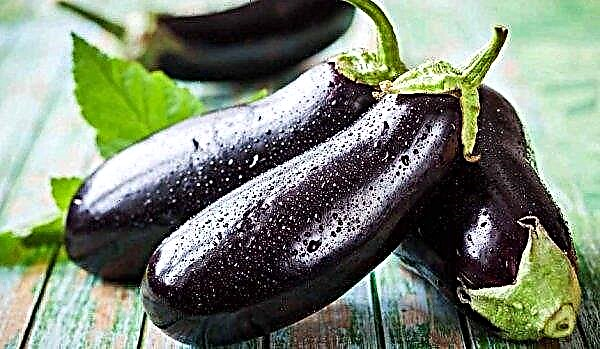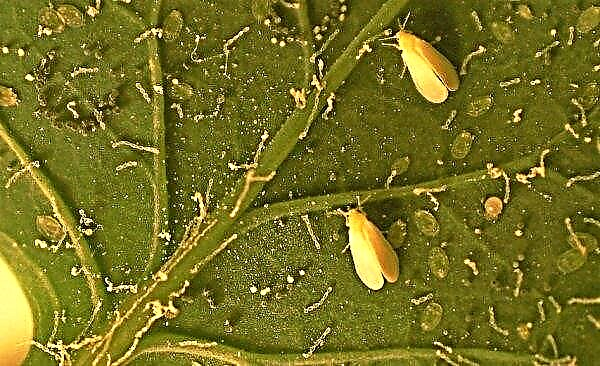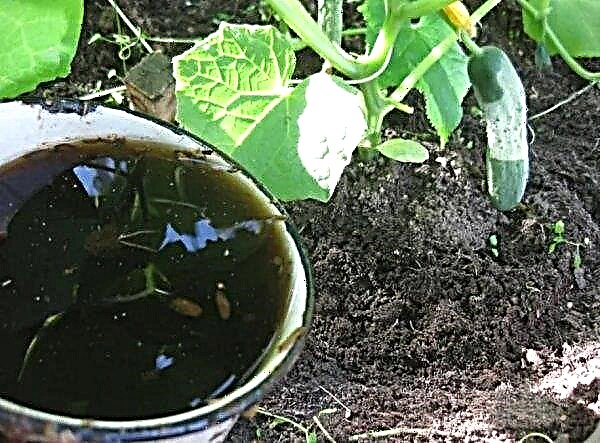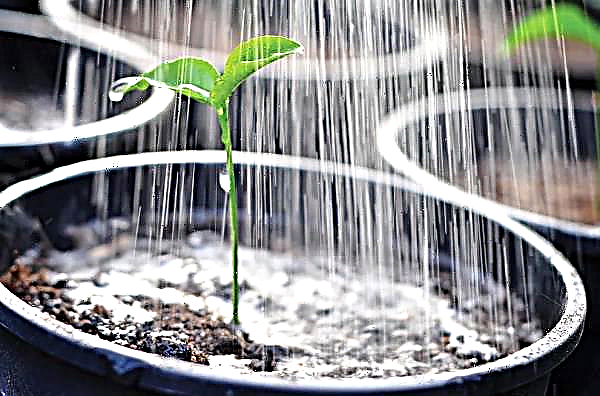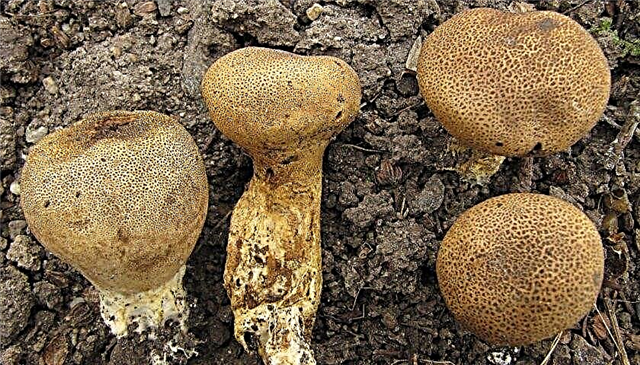Fresh cabbage can be used to prepare a wide variety of dishes, but it can also be an independent snack, if fermented. Crispy and tasty sauerkraut goes well with various side dishes and is a source of vitamins for the body. But sometimes the finished product can have an unpleasant bitter aftertaste. In this article, we will find out the main causes of this phenomenon, consider the rules for salting vegetables and ways to get rid of bitterness.
The benefits of sauerkraut
Sauerkraut does not lend itself to heat treatment, so vitamins and nutrients are stored in it. Usually it is fermented in the cold season, and it becomes a good addition to the winter diet, in which there are practically no fresh vegetables.
Did you know? According to one version, the name of this vegetable comes from the ancient Greek word “caputum” and translates as “head”.
- In addition to excellent taste, the product has a number of additional useful properties:
- during fermentation, the concentration of vitamin C increases in it;
- contains a large number of vitamins (A, B, C, K) and minerals (manganese, copper, iron, magnesium, calcium);
- improves the digestive system;
- strengthens the heart muscle;
- stimulates the metabolism in the body;
- has a low calorie content and can be used in the diet during the diet;
- strengthens the nervous system;
- prevents the occurrence of cancer;
- It is an effective anthelmintic;
- improves skin condition;
- lowers cholesterol;
- eliminates toothache;
- contains lactic acid, which protects the body from germs and bacteria;
- Helps fight depression and stress.
The basic rules of salting cabbage
In order for the appetizer to turn out delicious and retain the maximum number of useful properties, you need to choose the main ingredient correctly and correctly perform the salting procedure.
Preparation of sauerkraut is carried out according to the following rules:
- Rinse the vegetable in cold water and let the cabbage dry out of moisture.
- Before salting, peel the vegetable from the upper leaves and cut the stalk.
- Cut the head of cabbage into 4 parts and finely chop each of them with a knife into strips 0.5 cm wide so that the slices of the vegetable are better saturated with salt, but remain crunchy.
- Mix cabbage with salt in a wide bowl to ensure an even distribution of salt throughout the mass.
- In the process of mixing, it is recommended to slightly press down the mass with your hands to stimulate the formation of a sufficient amount of juice.
- For salting, you need to use a clean container of a suitable size, which has no odors. Glass jars are best suited for this purpose.
- Put chopped vegetables in jars in layers and tightly ram each of them with your hands.
- When the jar is filled almost completely (it remains 2-3 cm to the top), you need to cover the neck of the jar with a plastic lid, leaving a hole for air to enter.
- Put oppression on the top layer of cabbage in a jar - a glass of water or a large apple.
- During fermentation, the jar with pickles should be in a warm room with an air temperature of about +18 ... + 20 ° С. This process takes about 3-5 days.
- As you ferment, foam will form in the tank and you need to remove it.
Important! You need to take sauerkraut to a cool place only after the fermentation process is over and the foam ceases to form in the jar with pickles.
Why bitter
Bitter sauerkraut can result from errors in choosing the main ingredient or in violation of the cooking technique of this dish. At the same time, the fermentation process is not carried out actively enough and this leads to the propagation of harmful microorganisms, which cause an unpleasant bitter aftertaste of the finished product. Consider the main reasons for the appearance of a bitter aftertaste in the finished snack and we will figure out how to eliminate them.
Ignoring piercing before pickling
An unpleasant bitter taste in sauerkraut may appear if it was not pierced before pickling. In the process of interaction of vegetable juice with salt, a special acidic environment is formed inside the tank. As a result of the fermentation process, gases are formed that cannot exit the tank on their own. Accumulating in the product, they are the cause of an unpleasant odor, which affects the taste of the vegetable, so pickles acquire a bitter aftertaste.
To prevent the occurrence of bitterness, it is recommended to carry out such actions:
- Before cooking, pierce the head in several places with a sharp wooden stick to release carbon dioxide.
- In the process of fermentation, pierce the mass in a jar with a wooden stick to the bottom, so that carbon dioxide does not accumulate and goes out. Repeat this procedure 2 times a day.
- After laying shredded cabbage in cans, you can immediately insert a wooden stick in the center of the container - it absorbs an unpleasant odor and prevents the occurrence of bitterness.
Large amount of salt
The bitter taste of pickles can be caused by excess salt. At room temperature, in a finely chopped and tightly laid cabbage mixed with salt, the fermentation process begins. It is the result of the activity of lactic acid bacteria, which are formed as a result of the contact of vegetable juice with salt. But with an excess of salt, lactic acid bacteria slow down their life and partially die, and the fermentation process slows down. As a result, a characteristic foam does not form in the jar of pickle, the taste of the vegetable deteriorates, and its color turns gray.
Did you know? Just 100 g of fresh cabbage contains about 60% of the daily dose of vitamin C for an adult.
To fix the problem, you need to do the following:
- drain part of the brine from the can and top it with clear cold water;
- if no more than 1–2 days have passed after salting, you can add a small portion of fresh cabbage to the pickle, mix and put it again in a warm place for fermentation;
- if salting was noticed a long time after putting the mass in jars, you can use the salted product for cooking cabbage soup, borsch or as a filling for pies.
Not enough salt
The bitter taste of cabbage can be caused by a lack of salt used for cooking. The active fermentation process is possible only with the interaction of vegetable juice with salt in a warm room. With a lack of salt inside the tank, the necessary medium is not formed in which beneficial lactic acid bacteria multiply. Instead, under the influence of heat, harmful bacteria multiply in the cabbage, which cause rotting of the product.
Signs of a lack of salt in a jar of pickle are:
- gray color of slices of vegetable;
- cabbage becomes soft;
- the snack is not salty to taste;
- the appearance of an unpleasant odor;
- the mass in the jar is covered with mucus.
If the problem was noticed at an early stage of preparation, you can make up for the lack of salt in the jar. To do this, drain part of the brine and add fresh saline to the tank to stimulate the onset of fermentation. If the lack of salt was noticed a few days after the preparation of the snack and the vegetable managed to become soft and mucilage, then salting will not succeed. In addition to unpleasant bitterness, such a dish can cause poisoning in the human body.
Important! In a standard recipe for sauerkraut, for every 10 kg of vegetable you need to spend 200 g of salt.
Unsuitable grade for pickling
For salting, you can use only medium and late ripening cabbage. In early vegetables, the heads of cabbage are too loose, and the leaves are thin and green. They are good for making fresh salads, but they contain a minimum of sugar and become bitter during fermentation. Dense white heads of cabbage, which accumulate a lot of sugar during ripening, are more suitable for salting. It is because of this that the juice of vegetables, which is released during the starter process, has a sweetish flavor and, in combination with salt, makes the finished snack especially tasty.
The following varieties are best suited for salting:
- Moscow late;
- Valentine F1;
- Kharkov winter;
- Belarusian;
- Present;
- Glory;
- Atria F1;
- Megaton F1.
Unsuitable cutting time during cultivation
Sometimes the bitter taste of sauerkraut appears as a result of the fact that it was cut off from the garden at the wrong time. So that during the salting, the vegetable does not appear bitterness, it must be fully ripe.
Here are a few rules for choosing the right head for pickling:
- it is recommended to cut the vegetable no earlier than 2 days after the first frost, since it is at this point that it fully ripens;
- cabbage should be dense, crackle slightly when pressed by hands;
- the head should have a white color, it indicates that there is enough sugar in the leaves of the vegetable;
- the stump should be juicy and dense;
- after the cut, the head of cabbage needs to lie down for another 1-2 weeks to finally gain maturity.
How to get rid of bitterness
The easiest way to familiarize yourself with the rules of fermentation of cabbage before cooking to avoid an undesirable bitter aftertaste. But if for some reason the finished product still has a bitter taste, then you can try to eliminate it with a little tricks.
Did you know? Sour cabbage began to be prepared in China in the 3rd century. BC e., steeping a vegetable in wine for several days.
Consider the main ways of how to correct the mistakes made and get rid of bitterness in the finished product:
- Put the pickles on a plate and let it air for some time. To improve air circulation, the product must be mixed periodically.
- Prepare pickled appetizer from bitter sauerkraut. To do this, you need to squeeze the juice out of it, and then add a little sugar and vinegar, half an onion and vegetable oil. The resulting mixture is laid out in glass jars and stored in a cool place.
- Use bitter sauerkraut for cooking cabbage soup, stewing or frying. In the process of heat treatment, the bitter taste will completely disappear.
- Drain the whole juice from the container with pickles and fill it with new brine made from water, salt and sugar. After this procedure, the snack will partially lose its flavor, but the unpleasant bitter taste will go away. Salt and sugar for the preparation of a new brine must be taken in equal proportions.

Cooking Tips
The process of fermenting cabbage is not overly complicated if you adhere to the above rules. But besides this, there are a few more tricks that will help make the appetizer delicious, crunchy and healthy.
Important! It is not recommended to rinse the prepared sauerkraut with water. This will make it soft and lead to the loss of all nutritional properties.
Consider some tips for cooking sauerkraut:
- it is recommended to use ordinary table salt for salting, because iodized will give an unpleasant aftertaste of salt;
- it is best to ferment a vegetable in glass jars with a volume of 2 or 3 liters, so that the product does not have time to deteriorate;
- during the preparation of snacks use the amount of salt indicated in the recipe;
- for the preparation of sauerkraut, you can use glass, wooden or enameled containers, but it is not recommended to ferment a vegetable in a plastic container or stainless steel dishes;
- start the fermentation of cabbage should be in mid-autumn;
- if a fresh vegetable initially has a bitter taste, it is recommended to pre-soak it in cold water, and only then use it for salting;
- in addition to salt, carrots, horseradish, peppers and other spices are often added to the product;
- if you add grated carrots to the appetizer, the cabbage will turn a light pinkish color;
- to prevent the growth of bacteria, it is recommended to spread honey on the walls of the tank before laying cabbage in it;
- to combat mold, it is recommended to put horseradish leaves in a jar of cabbage;
- you need to make sure that the brine in the tank is enough and it completely covers the vegetables.





